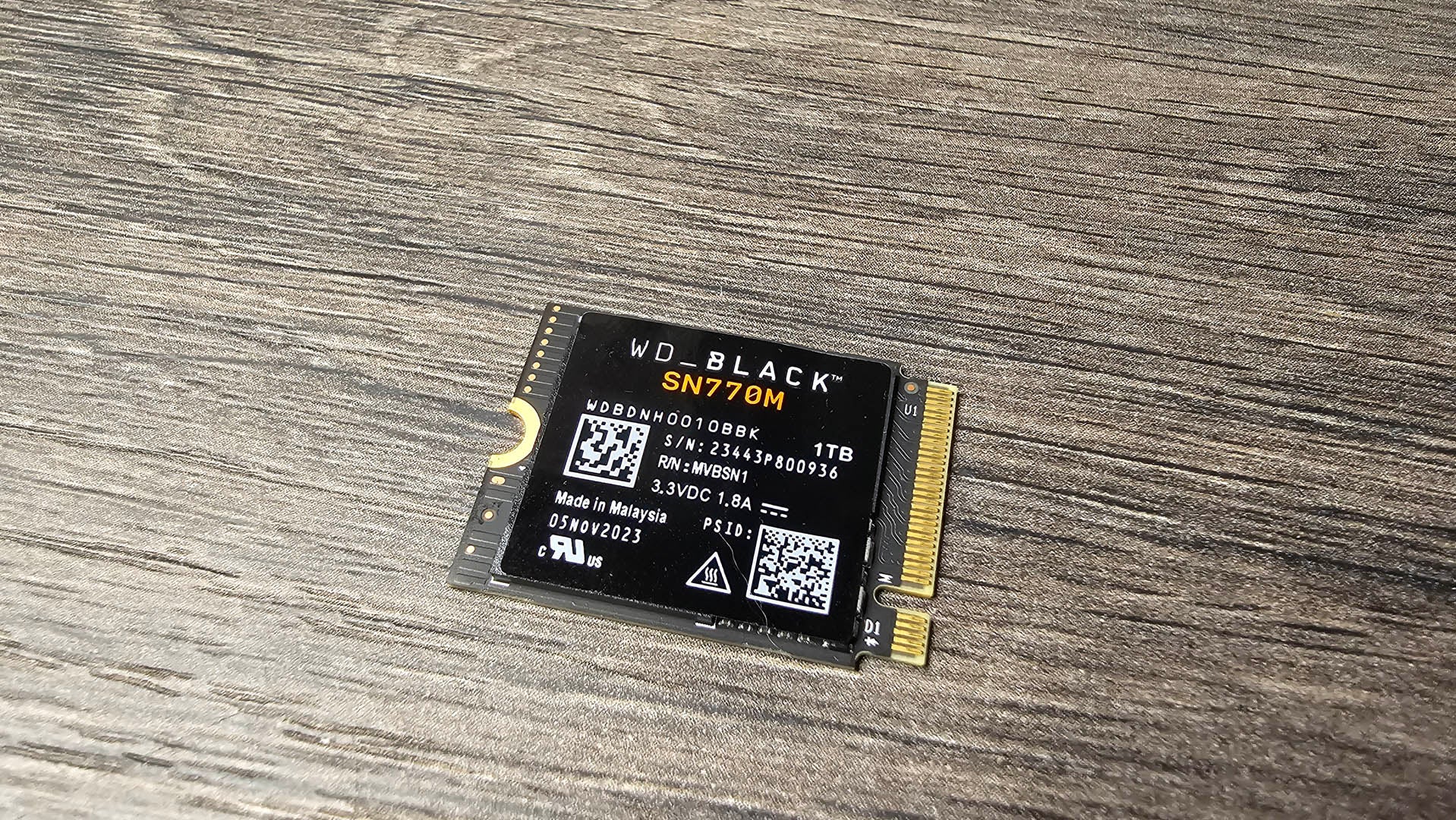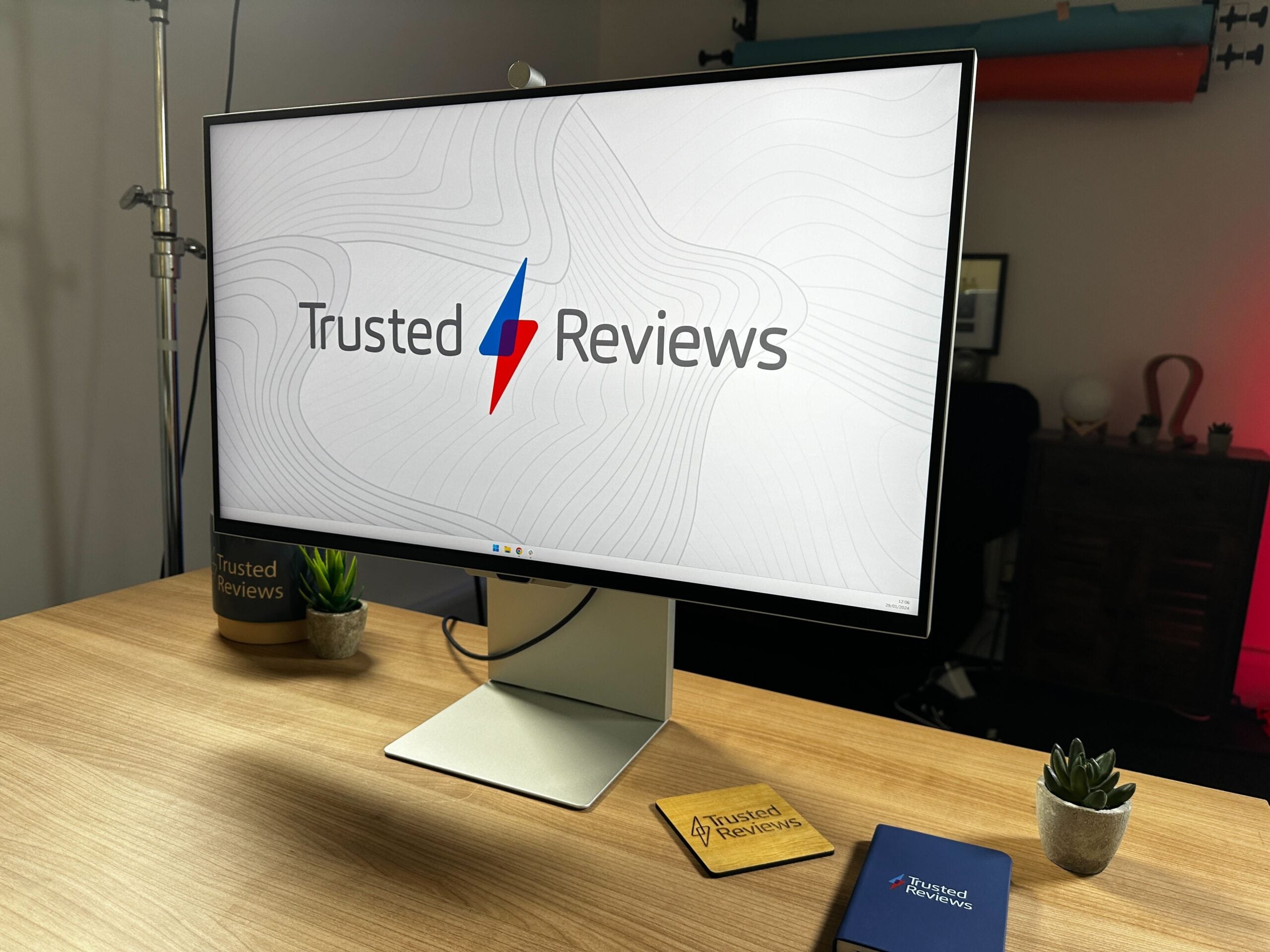Lenovo Yoga Slim 7i Pro X Review
A cheaper alternative to the MacBook Pro
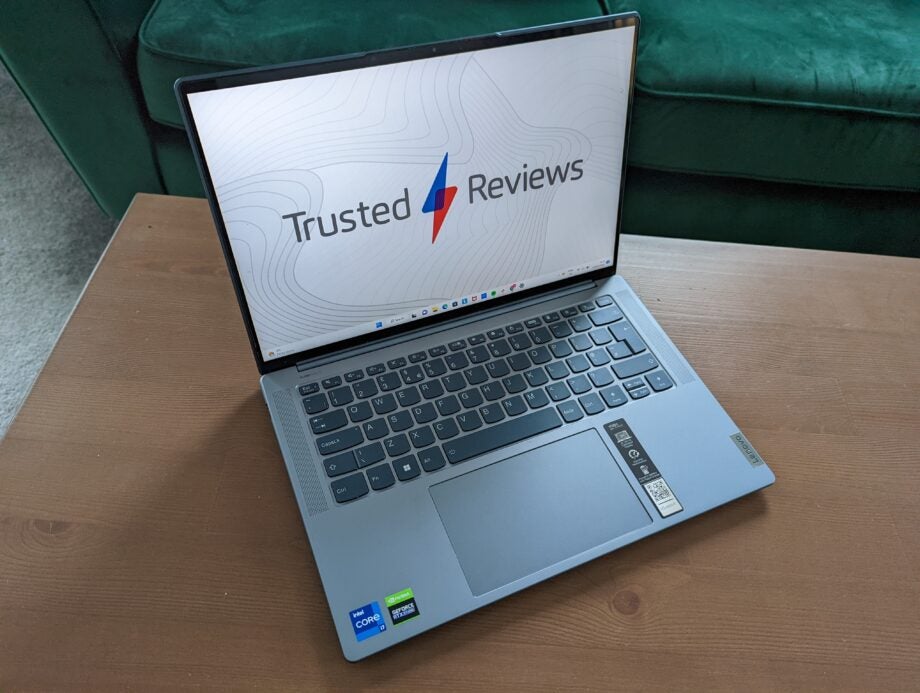

Verdict
The Lenovo Yoga Slim 7i Pro X is a well balanced laptop, capable of casual gaming and content creation. If your budget can’t stretch to a MacBook Pro, this is a fantastic compromise.
Pros
- Fast performance
- Fantastic port options
- 3K screen resolution with 120Hz refresh rate
- Low price considering specs
Cons
- Restrictive battery life
- Fans can get loud
- Mediocre colour coverage
Availability
- UKRRP: £1576
- USARRP: $1595
Key Features
- Optional discrete graphics:Lenovo offers up the option of a GTX 1650 or RTX 3050 graphics chip, resulting in a speedy performance for entry-level gaming and content creation.
- 3K resolution screen:This laptop is capable of presenting sharp pictures with a 3K resolution, while the 120Hz refresh rate keeps fast motion appearing smooth.
- Portable design:With a 14-inch screen and starting weight of 1.5kg, this laptop is small and light enough to take to and from the office without issue.
Introduction
Windows laptops have been attempting to offer a similar experience to a MacBook Pro for years now, and few have managed to strike that perfect balance of stylish design, breakneck performance and long battery life.
The Lenovo Yoga Slim 7i Pro X is a long way from meeting those lofty targets, settling for an entry-level graphics performance, but it makes up for that with a more affordable price point.
There isn’t really any key feature or spec that makes this laptop stand out from the crowd, but it nevertheless has a great all-round balance of specs and features to make this a viable alternative to the MacBook Pro for those on a budget.
Design
- Subtle style, with grey colour option
- Slim design considering the specs
- No fingerprint sensor
The Lenovo Yoga Slim 7i Pro X has an unremarkable design that’s unlikely to draw the eye in a coffee shop or office. But it still looks great, with a thin bezel surrounding the 14.5-inch screen and rounded edge on the rim of the chassis.
Lenovo lists this laptop as being painted in grey, but I can see a subtle blue tint to it, making it more of an eye pleaser than the average laptop.
It’s surprisingly slender considering my model is packing both a high-end processor and a discrete GPU. With a height of 15.9mm, it’s only marginally thicker than the 14-inch MacBook Pro (15.5mm) despite the latter using a single chip to store both the CPU and GPU cores.
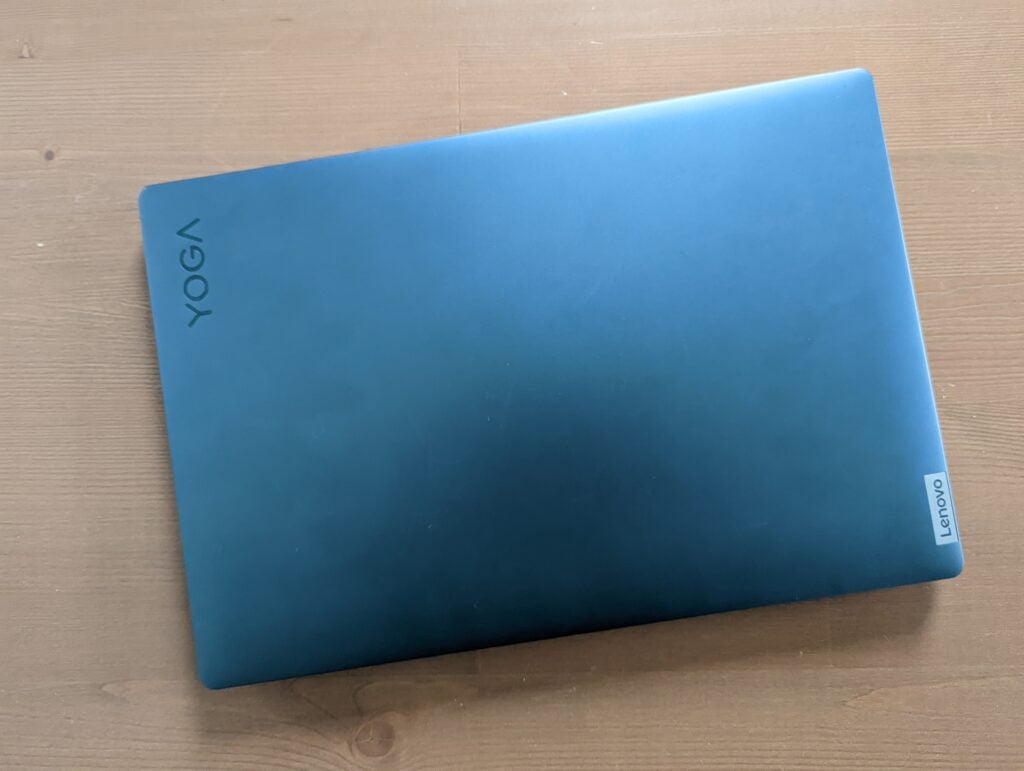
I’ve carried the laptop around the office with one hand, although it’s just about heavy enough (starting at 1.5kg) to cause strain to my wrist. It’s no problem in a rucksack though, as I’ve thrown it inside my bag along with a Dell XPS 13 laptop and tablet, and still had no problem commuting to and from work.
Lenovo has opted for a clean look on the laptop’s lid, with a shiny ‘Yoga’ logo stretching down the top-left corner, and a little Lenovo badge on the opposite side. Otherwise, it’s just a plain metallic lid. When light hits the surface, the metallic lid does shine proudly, but also draws attention to all of my fingerprint smudges.
The ‘Lenovo Yoga’ moniker is arguably misleading, as the laptop’s hinge cannot be rotated by 360-degrees, unless you plan on snapping it. The laptop has seemingly done some entry-level yoga classes though, as I’m able to bend the screen back as far down as the desk, but I’m not convinced there’s much use case for such a form.
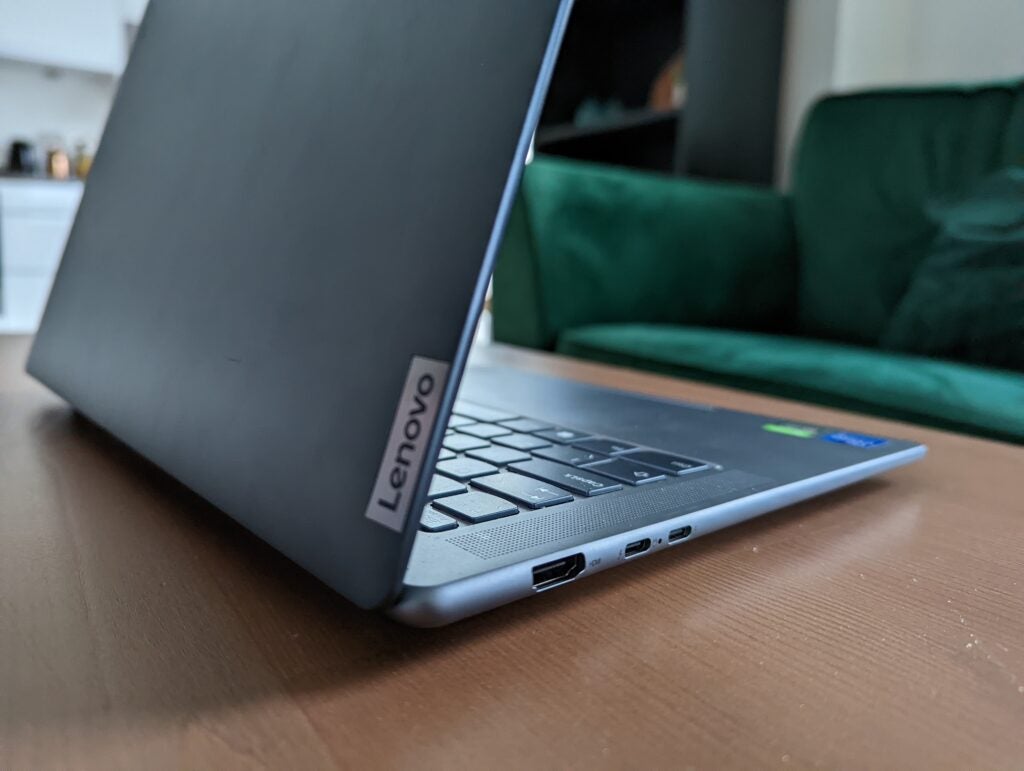
Despite the Yoga being so thin, Lenovo has still managed to cram numerous ports onto the laptop, including a headphone jack, USB-A port, 2x USB-C (with Thunderbolt 4 support) and HDMI – that’s a superb selection that puts the likes of Apple and Dell to shame, who have suggested their laptops are now too thin to host legacy ports.
You’ll even find a webcam kill switch on the right edge, which cuts the power to the sensor so you can be sure nobody is snooping on you. The 1080p webcam looks a little grainy, struggling to pick up much detail in low light. But it’s still perfectly serviceable for Zoom catch ups with friends and colleagues.
The keyboard is sandwiched between two up-firing speakers, and yet still has plenty of space for chunky keys that are easy to hit no matter your typing speed. There’s no number pad, but that’s normal for a 14-inch laptop these days.
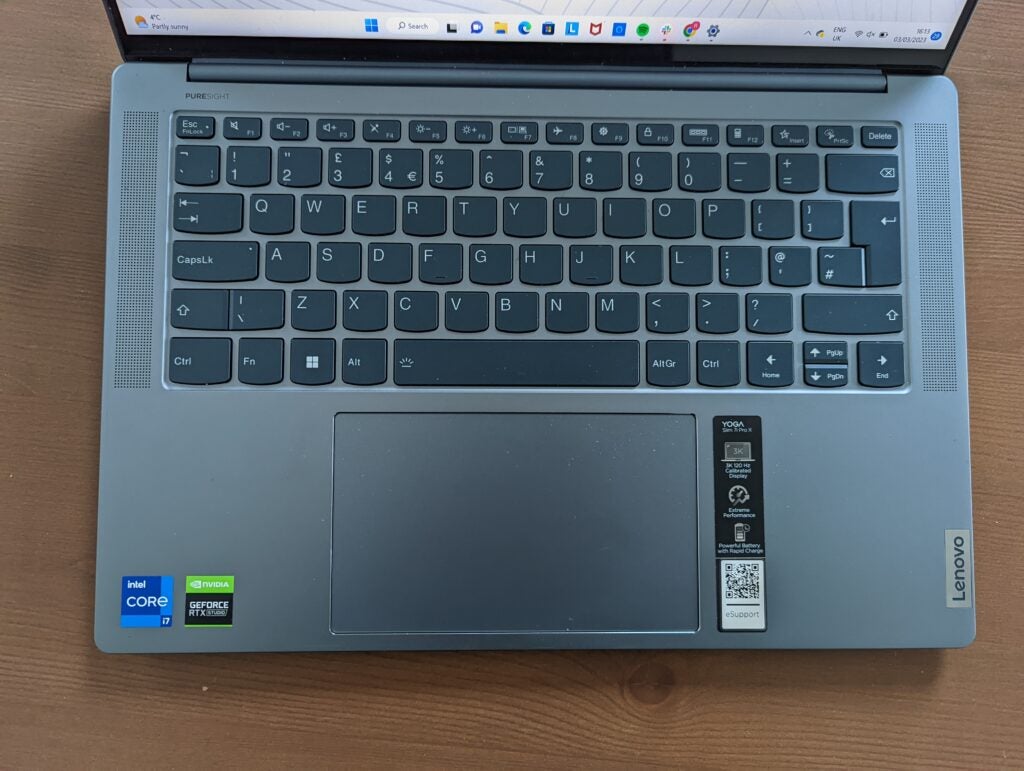
I’m a little disappointed by the lack of a fingerprint sensor for hassle-free logins, but Lenovo has ensured Windows Hello support for the webcam instead. That means the laptop will sign you in as soon as it recognises your face, although this feature can be a little temperamental, especially if you’re not in a brightly lit room.
Lenovo has opted for a physical trackpad rather than being tempted over by haptic feedback. It’s massive, smooth and responsive – and so ticks all of my boxes.
Screen
- A 14.5-inch screen with 3K resolution
- 120Hz refresh rate
- Lacks the colour coverage of MacBook Pro
The Lenovo Yoga Slim 7i Pro X features a 14.5-inch panel, which doesn’t sound huge on paper, but makes the 13-inch screen of the Dell XPS 13 look absolutely tiny in comparison. The Lenovo looks like a big-screen laptop, and yet remains small enough that it’s easy to transport.
It features a high 3K (3072 x 1920) screen resolution. Video and pictures look sharp, although the IPS screen technology doesn’t look quite as bold and punchy as an OLED (Dell XPS 13 OLED) or Mini LED (MacBook Pro) display.
For testing purposes, I used a colorimeter to dive deeper into the Lenovo’s screen specs. A recorded max brightness of 416 nits is above the average (300 nits) for a laptop, and so should be able to still be visible in bright light – although that’s hard to test in the gloomy months of February and March.
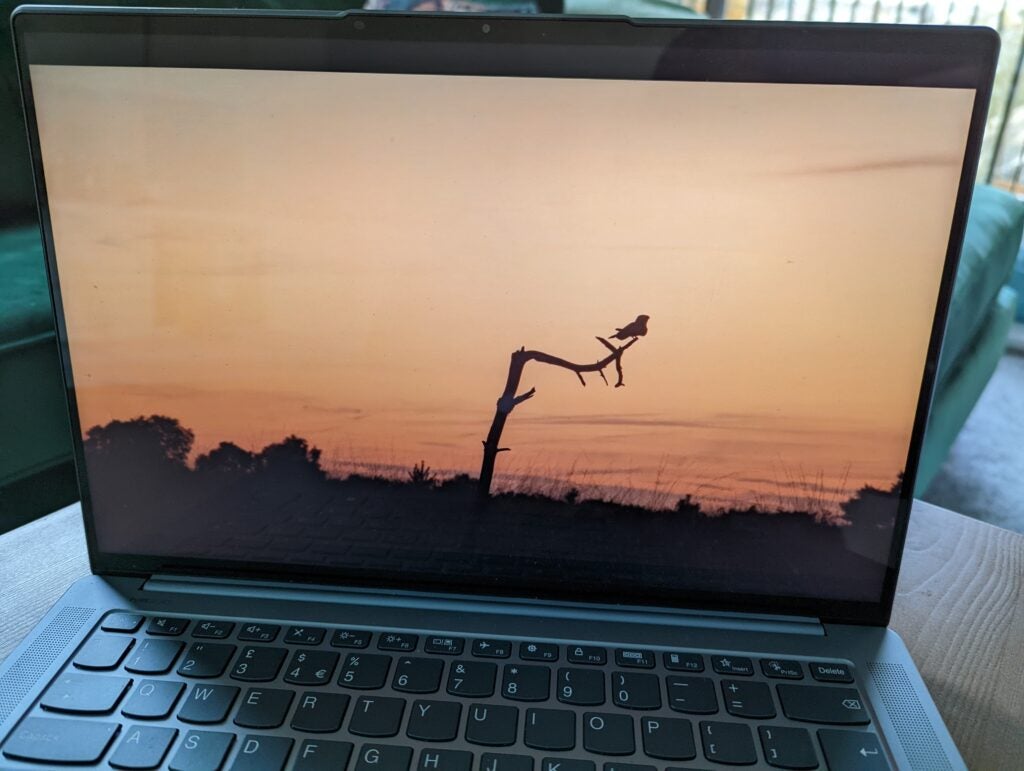
Sadly, the laptop struggles when displaying pitch black scenes, which appear a little too grey for my liking. This is backed up by a mediocre black level of 0.32 nits, resulting in an overall contrast of 1290:1. Such a result is perfectly fine, although you will get better results by spending more.
The colour coverage is good, with 99% coverage of sRGB. But the mediocre Adobe RGB and DCI-P3 results both came in at 73%, which is just about good enough for entry-level content creators, although seasoned professionals will likely want a more accurate display.
A 120Hz refresh rate comes as standard, allowing for smooth on-screen motion, especially if you intend on playing games on this laptop.
Lenovo also provides you with the option to pick either a non-glare or glare display, while also offering you to upgrade to a touchscreen for an additional charge.
Performance
- Powered by 12th Gen Intel chip
- Optional discrete GPU from Nvidia
- Fans are very loud
The Lenovo Yoga Slim 7i Pro X is powered by Intel’s 12th Generation of processors, with the option of either an i5-12500H or i7-12700H chip via an extra upgrade. Intel recently entered its 13th generation of processors, although you’re still getting plenty of power with the Lenovo.
You get Intel’s standard integrated graphics by default, although Lenovo is also offering up two optional GPU upgrades: Nvidia’s GTX 1650 for an extra £160 or RTX 3050 for £230 more.
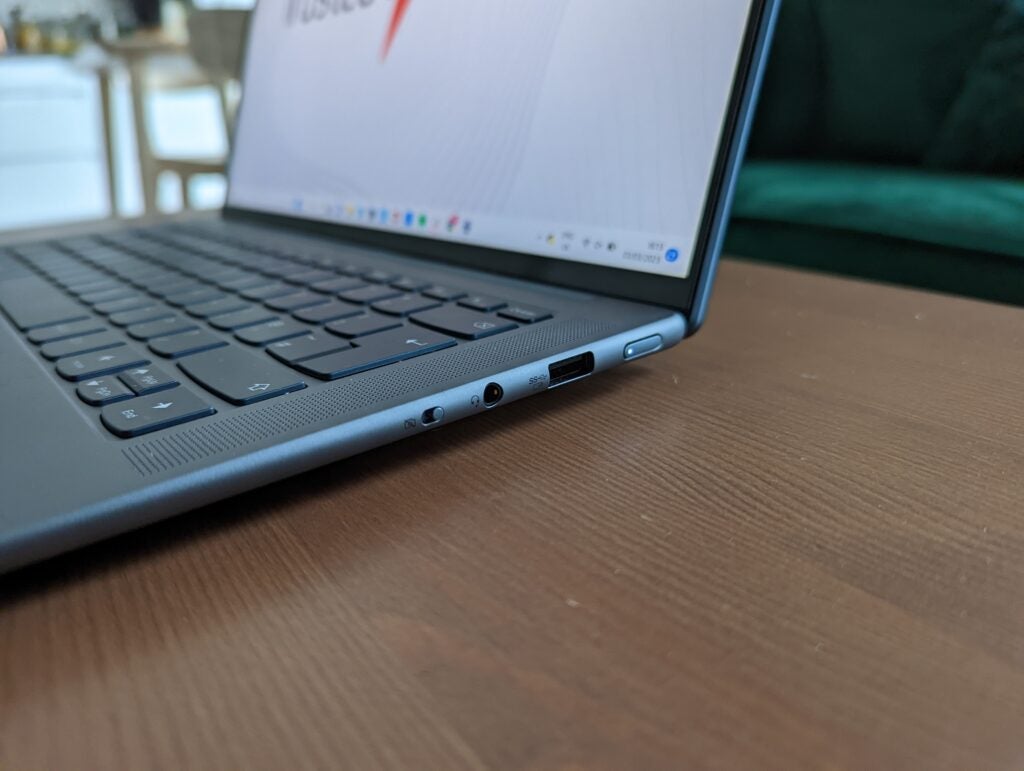
Lenovo sent me the top configuration, with an Intel Core i7-12700H chip, Nvidia RTX 3050, 32GB of DDR5 RAM and a 1TB SSD. The total cost comes to £1576, which is extremely good value – the cheapest 14-inch MacBook Pro retails for £2149, although is admittedly more powerful.
If you’re happy to scale down the specs (which includes the removal of a discrete GPU), then you can buy the Lenovo Yoga Slim 7i Pro X for as little as £1063.99, which remains great value.
But how does the performance of the Lenovo Yoga Slim 7i Pro X compare to other laptops? I used some benchmark tests to find out, and you can check the results in the graph below.
As you can see, the MacBook Pro wipes the floor with Lenovo, posting superior scores for both the CPU and GPU performance. But it’s important to remember Apple’s Pro laptop is almost twice as expensive too.
I’m impressed with the scores of the Lenovo Yoga Slim 7i Pro X considering its price. I sped through web browsers and apps, to such an extent that it was immediately obvious of the performance boost when switching from the Dell XPS 13. The performance is even good enough for entry-level content creation such as photo/video editing.
Gaming performance was decent – when playing Horizon Zero Dawn with max graphics settings and a resolution of 1440p, the Lenovo laptop was able to hit an average frame rate of 33fps. Dialling the resolution down to 1080p saw that performance increase to 36fps.
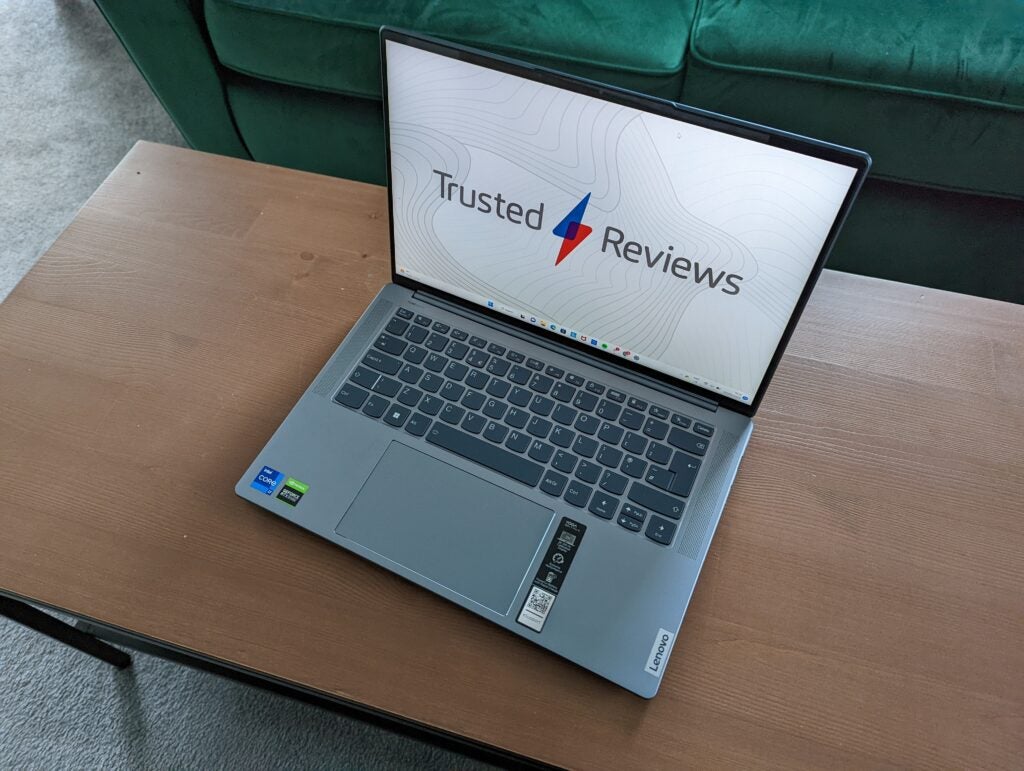
This is certainly not going to compete with a proper gaming laptop such as the Asus Zephyrus G14, but if you’re realistic with the graphics settings, you can still play some casual games on the side – something like Stardew Valley, Football Manager and The Sims should work perfectly fine.
But be warned that the fans can whir up to a really loud volume when the laptop is under stress. It’s nothing a pair of headphones can’t block out, but it may prove to be a distraction in an office setting.
The SSD speeds are perfectly adequate, with a read score of 3438MB/s and a write score of 3288MB/s. That’s about average for a productivity laptop, although we are starting to see a trend of laptops using super-speedy internals to make boot-up times and app load-ups even faster.
Battery life
- Battery test lasted just short of 7 hours
- Can’t match the MacBook Pro for stamina
The biggest downside of adding in a discrete GPU, such as the optional Nvidia’s GTX 1650 and RTX 3050 chips on offer with the Lenovo, is that they can be a major leech on battery life – that’s the trade-off for speedy graphics performance.
Since my model of the Lenovo Yoga Slim 7i Pro X packs the RTX 3050, it wasn’t a big surprise to see battery life limited to just 6 hours and 51 mins in our PCMark 10 office simulation benchmark. That’s subpar stamina, especially when compared to the MacBook Air M2 which can last over 13 hours away from the mains.
I also tested the battery life by looping a 1440p YouTube video. The Lenovo only lasted 4 and a half hours this time, which may be bad news for those who want to watch Netflix at the highest resolution possible.
If you decide to buy a model that doesn’t feature a discrete graphics chip, you will no doubt see a major boost to the laptop’s stamina. It’s great to be able to choose between the two priorities, but it’s a compromise you don’t have to make when buying a MacBook Air.
Latest deals
Should you buy it?
You want a great value laptop for entry-level content creation: The Lenovo Yoga Slim 7i Pro X is one of the best Windows laptops I’ve tested at this price for entry-level content creation, with a high-resolution display and fantastic performance.
You want great battery life: The 7 hour battery life of the Lenovo Yoga Slim 7i Pro X is by no means poor given the specs, but you will find much better stamina by opting for a MacBook Air or MacBook Pro.
Final Thoughts
The Lenovo Yoga Slim 7i Pro X is one of the best value Windows laptops I’ve seen for entry-level content creators. The price is very reasonable when packing in specs such as an RTX 3050 GPU, 32GB of RAM and a 1TB SSD.
The MacBook is the most obvious rival, with the Lenovo sitting somewhere between the M2-powered Air and M2 Pro toting Pro in terms of processing power. But the Lenovo struggles to compete when it comes to battery life and colour coverage, making it difficult to recommend to the professional creative crowd.
But if you’re looking for a cost-effective MacBook alternative with enough power for casual gaming, then the Lenovo Yoga Slim 7i Pro X is a superb option.
How we test
Every laptop we review goes through a series of uniform checks designed to gauge key things including build quality, performance, screen quality and battery life.
These include formal synthetic benchmarks and scripted tests, plus a series of real-world checks, such as how well it runs the most frequently used apps.
We also make sure to use every laptop we review as our primary device for at least a week to ensure our review is as accurate as possible.
Spent at least a week testing the laptop.
Use benchmark software to evaluate performance.
Tested the screen with professional equipment.
Tested the battery life.
FAQs
The touchscreen is optional, requiring an additional £50 charge.
The i usually signifies that the laptop is powered by an Intel processor, opposed to an AMD chip.


